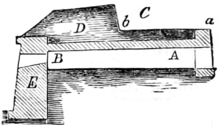

In fortification architecture, a terreplein or terre-plein is the top, platform, or horizontal surface of a rampart, on which cannon are placed,[1] protected by a parapet.[2] In Martello towers, the roof or terreplein was sometimes surmounted with one or two cannon mounted on a gun platform with a central pivot, that enabled the guns to traverse up to 360 degrees.[3]
In civil engineering works, a terreplein is an embankment of earth with a broad level top, which is sometimes excavated to form a continuation of an elevated canal across a valley.[1]
Notes and references
[edit]- ^ a b Webster's International Dictionary of the English Language, Vol 2, 1895
- ^ Griffith, Paddy (2006), The Vauban Fortifications of France, Osprey Publishing, ISBN 978-1-841768755 (p. 63)
- ^ Clements, Bill (2011), Martello Towers Worldwide, Pen & Sword Military, ISBN 978-1-84884-535-0 (pp. 37-38)
Well, that’s interesting to know that Psilotum nudum are known as whisk ferns. Psilotum nudum is the commoner species of the two. While the P. flaccidum is a rare species and is found in the tropical islands. Both the species are usually epiphytic in habit and grow upon tree ferns. These species may also be terrestrial and grow in humus or in the crevices of the rocks.
View the detailed Guide of Psilotum nudum: Detailed Study Of Psilotum Nudum (Whisk Fern), Classification, Anatomy, Reproduction